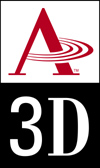Xitel Storm Platinum Gamer's Pack
by Mike Andrawes on June 13, 1999 9:37 PM EST- Posted in
- Smartphones
- Mobile
A3D 2.0
 Aureal's
A3D technology is based on the concept that we can tell where a sound is coming
from with just two ears, so it must be possible to produce three dimensional
sound using just two speakers. Over two decades of research into our ability
to distinguish the location of a sound with just two ears and a number of technologies
have grown out of that research, including A3D. A3D
1.0 uses Head-Related Transfer Functions (HRTF) to simulate the effect of a
sound wave traveling into the ear and modifies that sound wave to make it sound
as if it is coming from a specific location.
Aureal's
A3D technology is based on the concept that we can tell where a sound is coming
from with just two ears, so it must be possible to produce three dimensional
sound using just two speakers. Over two decades of research into our ability
to distinguish the location of a sound with just two ears and a number of technologies
have grown out of that research, including A3D. A3D
1.0 uses Head-Related Transfer Functions (HRTF) to simulate the effect of a
sound wave traveling into the ear and modifies that sound wave to make it sound
as if it is coming from a specific location.
A3D 2.0 builds on this basic concept from A3D 1.0 by adding in wavetracing to simulate the effect of a sound wave traveling through a three dimensional environment - all done using the 3D geometry of the room from the games engine. This primarily means reflections off walls, occlusions by walls, Doppler effect, acoustic reverberation, and atmospheric absorption. Aureal website offers a complete white paper on A3D, covering the complete theory in full detail.
For example, imagine an audio source directly in front of you. You then leave the room by backing up through a door. In most games, the sound simply gets quieter as you move further away. But using A3D 2.0, the sound will actually get quieter because a wall is there and the higher frequencies become more muffled as they are obstructed by the wall. Now imagine turning the corner and walking down the hall. You're not really getting further away from the sound, so under normal circumstances, the sound would remain about the same volume. On the other hand, the sound would continue to change as A3D 2.0 calculates the amount of sound coming out of the door and bouncing towards the listener.
The wavetracing effect is truly amazing and must be heard to fully understand - this reviewer was definitely skeptical until hearing it in person. A number of demos from Aureal are included on the driver CD that really show off the effect. Unfortunately, Xitel has chosen not to include any software beyond those demos and the drivers. The value of game bundles is of course debatable and this point is left to the reader to debate.
Despite being the more mature technology, the 3D positioning of the sound was less impressive than the wavetracing. As stated above, A3D's positioning was actually originally designed to be used with two speakers, and headphones would in fact be the ideal setup as the exact location of the speakers is known.
Unfortunately, the positioning was not as that convincing to this reviewers ears using headphones or two speakers, but others have disagreed and believe this is the best setup. For me, the quad speaker configuration provided the most realistic 3D imaging since the sound that is supposed to come from behind you really does come from behind you. This is of course the most complicated setup that can be used with the Vortex 2, but thankfully all those options are available so that each individual can make his/her own decision.
A3D 1.0 was released back in 1997, so its game support is quite extensive as of now. A3D 2.0 is not yet a year old, but is already garnering plenty of support from most developers who already used A3D 1.0. Interestingly enough, one of the most anticipated games of the year, Quake 3 Arena will not support 3D audio in any form (including Creative's EAX).










5 Comments
View All Comments
iosman - Wednesday, May 9, 2018 - link
Im in love with your content and also gain some knowledge from your blog.https://appvalleyandroid.com
https://192-168-l-254-ip.com
https://psiphonapp.com
iosman - Wednesday, May 9, 2018 - link
Love your blog man. Thanks for this stuff.https://tweakbox-app.com
https://tweakbox-app.org
https://gameguardianapp.com
AbbeyGrant - Saturday, June 9, 2018 - link
Now that's what I'm looking for clearly awesome thanks for the information.http://www.assist-login.com/fix-comcast-email-logi...
sandeeptinku - Thursday, August 2, 2018 - link
KingRoot is a Android program, which is largely built with the aim of rooting your smartphone.https://kingoroot-app.com/download/
https://kingoroot-app.com/
morgan4 - Thursday, June 20, 2019 - link
In love with this post.thankyou for the information.<a href="http://taylor411.com/salesforce-interview-question... lightning interview questions</a>